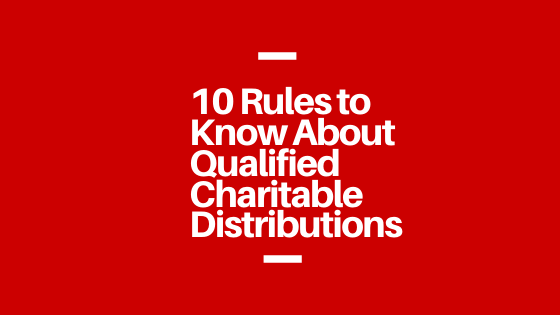TEG Retirement & Advisory Services- 10 Rules to Know About Qualified Charitable Distributions
–Denise Appleby, APA, CISP, CRC, CRPS, CRSP
If you are an IRA owner interested in donating to charity, a qualified charitable distribution may be an option. These 10 rules outline how a QCD should be done.
Arguably, one of the biggest changes to the tax code in the Tax Cuts and Jobs Act of 2017 was the doubling of the standard deduction. The Joint Committee on Taxation estimates that nearly 90% of taxpayers are likely to take the standard deduction instead of itemizing. The decision not to itemize means that charitable giving doesn’t seem like such a tax break.
But if you are over 70 1/2, qualified charitable distributions (QCDs) can be a favorable way to make donations to charities, because a distribution that meets the requirements as a QCD is excluded from gross income (so it’s nontaxable). Here are 10 features and requirements that apply to QCDs.
- QCDs have a dollar limit
You can make a QCD of up to $100,000 for a calendar year. For married couples, each spouse is subject to a separate $100,000 limit, leading to a total of $200,000 for a married couple.
2. December 31 deadline
A distribution must be processed by the end of the year to be considered a QCD for that year. All distributions processed between January 1 and December 31 of a calendar year can be treated as QCDs for that year, as long as they meet other requirements.
3. A 70½ age minimum
The account owner must be at least age 70½ on the date the QCD is processed. According to the tax code, you reach age 70½ six months after the date you turn age 70. Distributions processed before then are not eligible to be treated as QCDs.
4. They can only be made from IRAs
QCDs can only be made from IRAs, including inherited IRAs. QCDs cannot be made from SEP and SIMPLE IRAs that are ongoing—you receive an employer contribution for the plan year within the tax year in which you make the distribution.
If you want to use amounts held in an employer sponsored retirement plan to make a QCD, you must first roll over the amount from the plan to an IRA. Then the QCD can be made from the IRA.
Of course, the amount must be eligible for rollover to be considered a valid rollover to the IRA. Amounts not eligible for rollover include required minimum distributions (RMDs). Therefore, any RMD due from the plan for the year must be distributed to you before the rollover contribution is made from the plan to the IRA.
5. QCDs must be paid to the charity
A distribution made to you is not treated as a QCD. Instead, the distribution must be made payable to the charity. However, distributions made in the form of a check payable to the charity can be delivered to you, and you can then deliver the check to the charity.
6. The charity must be ‘eligible’
For this purpose, an eligible charity is one that meets the definition under Internal Revenue Code (IRC)170(b) (1)(A), other than an organization described in IRC 509(a)(3) or a donor-advised fund.
7. QCDs can be used to satisfy RMDs
A QCD can be used to satisfy an RMD if the RMD is not distributed before the QCD is processed. But any amount processed before the QCD is treated as an RMD up to your RMD due for the year, and is therefore not eligible for rollover.
Example 1: QCD is RMD
Jane’s RMD for the year is $10,000. In the first week of December, Jane (age 74) submitted instructions to her IRA custodian to process a QCD for $20,000 from her IRA. At that time, Jane had not yet made any other distributions from her IRA for the year.
Even though the $20,000 is paid to the charity and not Jane, $10,000 of the $20,000 QCD is counted towards Jane’s RMD for the year. As a result, Jane is not required to distribute any additional amount for the year for RMD purposes.
If Jane’s QCD was for $8,000, she would need to distribute only $2,000 to satisfy her RMD ($8,000 QCD +$2,000 regular distribution= $10,000 RMD).
Example 2: QCD is not RMD, and RMD is not eligible for rollover
Tom’s RMD for the year is $10,000. During the first week of December, Tom (age 75) instructed his IRA custodian to process a QCD for $20,000. He had already distributed $10,000 during the last week of November.
When Tom heard that a QCD can be used to satisfy an RMD, he wanted to roll over the $10,000 that he distributed in November. However, the amount was not eligible for rollover because the first distribution made during an RMD year goes toward satisfying the account owner’s RMD until the RMD is satisfied, which means that the $10,000 distributed in November is Tom’s RMD. Had Tom taken that $10,000 distribution after the QCD was processed, the amount would have been eligible for rollover.
8. QCDs not subject to pro-rata rule
Generally, an IRA distribution includes a prorated amount of pretax and after-tax funds, if your IRA balance includes basis amounts. Basis amounts come from nondeductible contributions and rollovers of after-tax amounts from employer-sponsored retirement plans.
For example, assume that you have one traditional IRA with the balance of $100,000, and $20,000 of that represents basis. If you take a distribution of $80,000 from the traditional IRA, the pro-rata rule would apply as follows $64,000 of pretax assets would be taxable and $16,000 of after-tax assets would be nontaxable, leaving a balance of $20,000. The pretax amount would be $16,000 and the basis would be $4,000.
One of the exceptions to this pro rata rule is a QCD. Under this exception, a QCD is deemed to come first from the taxable amount. Using the example above, if the $80,000 distribution is a QCD, then that entire amount would be attributed to the pretax balance, albeit nontaxable because it is a QCD. As a result, the remaining $20,000 would represent basis.
Note: All of your traditional, SEP, and SIMPLE IRAs are aggregated and treated as one for this purpose.
9. Not subject to tax withholding
IRA distributions are subject to income tax withholding. Under the withholding requirements, an IRA owner can request to have 10% or more withheld for federal income taxes plus any state tax. If you fail to make a tax withholding election, the IRA custodian/trustee is required to withhold 10% for federal income taxes.
One of the exceptions to this withholding rule is a QCD. Therefore, whether or not the IRA owner makes a withholding election, the IRA custodian must not perform any tax withholding on a QCD.
10. QCDs are reported as regular distributions
IRA custodians/trustees are required to report QCDs as regular distributions. Despite the fact that a QCD is nontaxable, the IRA custodian must report a QCD as a taxable distribution on IRS Form 1099-R. Your tax preparer is responsible for reporting the QCD as a nontaxable distribution on your return 1040.
If you submit a distribution request that is intended to be a QCD, you should notify your IRA custodian of your intention. This will help the IRA custodian to ensure that the amount satisfies the QCD requirement, including that amount that is made payable to the charity.
However, it is your responsibility as the IRA owner to ensure that the charity meets the requirement for being an eligible charity under the QCD rules. In addition, you must ensure that you meet the age 70½ requirement before the QCD is processed.
If you are considering a QCD, you should consult with a tax professional about whether or not it is the most suitable option for making a donation. A CPA should also be able to determine if it makes better tax sense to donate other assets.
Denise Appleby is CEO of Appleby Retirement Consulting, Inc., a firm that provides a wide range of retirement products and services to financial, tax, and legal professionals.
Denise Appleby, Appleby Retirement Consulting, TEG Retirement & Advisory Services are not affiliated with LPL Financial
Securities and advisory services are offered through LPL Financial (LPL), a registered investment advisor and brokerdealer (member FINRA/SIPC). Insurance products are offered through LPL or its licensed affiliates. TEG Retirement and Advisory Services at TEG Federal Credit Union are not registered as a broker-dealer or investment advisor. Registered representatives of LPL offer products and services using TEG Retirement and Advisory Services, and may also be employees of TEG Federal Credit Union. These products and services are being offered through LPL or its affiliates, which are separate entities from, and not affiliates of, TEG Federal Credit Union or TEG Retirement and Advisory Services. Securities and insurance offered through LPL or its affiliates are:



